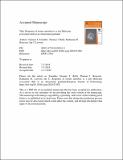Files in this item
Response of testate amoebae to a late Holocene ecosystem shift in an Amazonian peatland
Item metadata
| dc.contributor.author | Swindles, Graeme T. | |
| dc.contributor.author | Kelly, Thomas J. | |
| dc.contributor.author | Roucoux, Katherine H. | |
| dc.contributor.author | Lawson, Ian T. | |
| dc.date.accessioned | 2019-03-15T00:37:59Z | |
| dc.date.available | 2019-03-15T00:37:59Z | |
| dc.date.issued | 2018-06 | |
| dc.identifier | 252572440 | |
| dc.identifier | 1666b2b6-8ea1-4270-99c8-1f77d5365c88 | |
| dc.identifier | 85048906631 | |
| dc.identifier | 000438557300002 | |
| dc.identifier.citation | Swindles , G T , Kelly , T J , Roucoux , K H & Lawson , I T 2018 , ' Response of testate amoebae to a late Holocene ecosystem shift in an Amazonian peatland ' , European Journal of Protistology , vol. 64 , pp. 13-19 . https://doi.org/10.1016/j.ejop.2018.03.002 | en |
| dc.identifier.issn | 0932-4739 | |
| dc.identifier.other | RIS: urn:5CBDA27FFB2082D88E943EA1D66DA5A3 | |
| dc.identifier.other | ORCID: /0000-0001-6757-7267/work/64698074 | |
| dc.identifier.other | ORCID: /0000-0002-3547-2425/work/75996926 | |
| dc.identifier.uri | https://hdl.handle.net/10023/17289 | |
| dc.description | This work is funded by a Royal Society research grant to GTS (grant no. 481831). We acknowledge a quota PhD studentship, a radiocarbon facility grant (ref. 1747.1013) and a project grant (ref. NE/H011773/1) from the Natural Environmental Research Council (NERC). | en |
| dc.description.abstract | To date there have only been two studies using testate amoebae as palaeoecological indicators in tropical peatlands. Here we present a new ∼500-year testate amoeba record from San Jorge, a domed peatland in Peruvian Amazonia, which has a well-constrained vegetation history based on pollen analysis. We observe a major shift from Hyalosphenia subflava to Cryptodifflugia oviformis-dominated communities at ∼50 cm depth (c. AD 1760), which suggests a change to drier conditions in the peatland. The application of a statistical transfer function also suggests a deepening of the water table at this time. The transition in the microbial assemblage occurs at a time when pollen and geochemical data indicate drier conditions (reduced influence of river flooding), leading to an ecosystem switch to more ombrotrophic-like conditions in the peatland. Our work illustrates the potential of testate amoebae as important tools in tropical peatland palaeoecology, and the power of multiproxy approaches for understanding the long-term development of tropical peatlands. | |
| dc.format.extent | 7 | |
| dc.format.extent | 553178 | |
| dc.language.iso | eng | |
| dc.relation.ispartof | European Journal of Protistology | en |
| dc.subject | Amazonia | en |
| dc.subject | Amazon Rainforest | en |
| dc.subject | Palaeohydrology | en |
| dc.subject | Testate amoebae | en |
| dc.subject | Tropical peatlands | en |
| dc.subject | GE Environmental Sciences | en |
| dc.subject | NDAS | en |
| dc.subject.lcc | GE | en |
| dc.title | Response of testate amoebae to a late Holocene ecosystem shift in an Amazonian peatland | en |
| dc.type | Journal article | en |
| dc.contributor.institution | University of St Andrews. School of Geography & Sustainable Development | en |
| dc.contributor.institution | University of St Andrews. Bell-Edwards Geographic Data Institute | en |
| dc.identifier.doi | 10.1016/j.ejop.2018.03.002 | |
| dc.description.status | Peer reviewed | en |
| dc.date.embargoedUntil | 2019-03-15 |
This item appears in the following Collection(s)
Items in the St Andrews Research Repository are protected by copyright, with all rights reserved, unless otherwise indicated.

